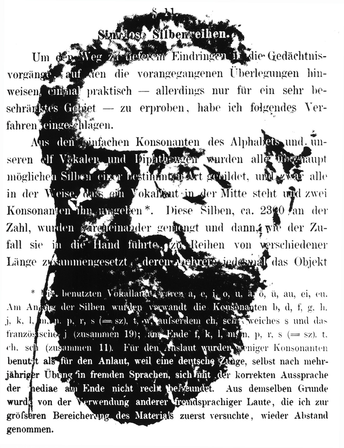Hermann Ebbinghaus1850–1909
One of the aims of neuroscience is to gain an understanding of the ways memories are laid down and retrieved. In order to do this, there needs to be some way of assessing memory. Many theoretical and experimental techniques had been applied to animals but less success had been achieved with humans. Ebbinghaus invented a quantitative method for studying learning. “In the realm of mental phenomena, experiment and measurement have hitherto been chiefly limited in application to sense perception and to the time relations of mental processes. By means of the following investigations we have tried to go a step farther into the workings of the mind and to submit to an experimental and quantitative treatment the manifestations of memory. The term, memory, is to be taken here in its broadest sense, including Learning, Retention, Association and Reproduction.” Ebbinghaus was trained in philosophy and might have remained in that discipline but for the chance discovery on a visit to London of an old copy of Fechner’s Elemente der Psychophysik. He sought to apply the rigour of the psychophysical methods to the study of memory. The then current methods of introspection were of little assistance in this regard, and so new techniques were required. The one he invented was the use of nonsense syllables. He made up approximately 2,300 consonant-vowel-consonant sequences, which could be randomly sorted into lists of varying length. The nonsense syllables reduced (but did not eliminate) the meaningfulness of the individual items; they could be learned to some criterion and then recalled and relearned at some later time. “The aim of the tests carried on with these syllable series was, by means of repeated audible perusal of the separate series, to so impress them that immediately afterwards they could voluntarily just be reproduced. This aim was considered attained when, the initial syllable being given, a series could be recited at the first attempt, without hesitation, at a certain rate, and with the consciousness of being correct.” With himself as the sole subject, Ebbinghaus established fundamental principles of learning and retention, including the forgetting curve, and that slight increases in the amount of material to be learned results in large increases in learning time (now referred to as the Ebbinghaus law). Ebbinghaus was born in Barmen; he received training in the humanities at the Universities of Bonn, Halle, and Berlin before obtaining a doctorate in philosophy at the University of Bonn. He then studied independently for seven years before being appointed to a post at the University of Berlin. One year after publishing his book on memory he set up a psychological laboratory there, and he opened another at Breslau in 1894. He was co-founder of the Zeitschrift für Psychologie und Physiologie der Sinnesorgane in 1890, and his textbook Principles of Psychology (1897) was very popular and ran to three editions. Despite these diverse influences on psychology, it is his research on forgetting for which he is remembered. The text in which Ebbinghaus’s portrait is embedded is taken from his book Über das Gedächtnis. Untersuchungen zur experimentellen Psychologie (1885), where the use of nonsense syllables is first described.
